History of the Shrine
How it Began
The National Shrine of St. Thérèse began as the dream of Fr. William G. LeVasseur, S.J. (Society of Jesus, or the Jesuits). Fr. LeVasseur saw the need for a retreat center in Alaska. He approached Bishop Crimont, the first Bishop of Alaska, and asked for permission to build the retreat center. Bishop Crimont had a deep devotion to St. Therese and knew members of her family, so he wanted the retreat center to be dedicated to St. Therese.
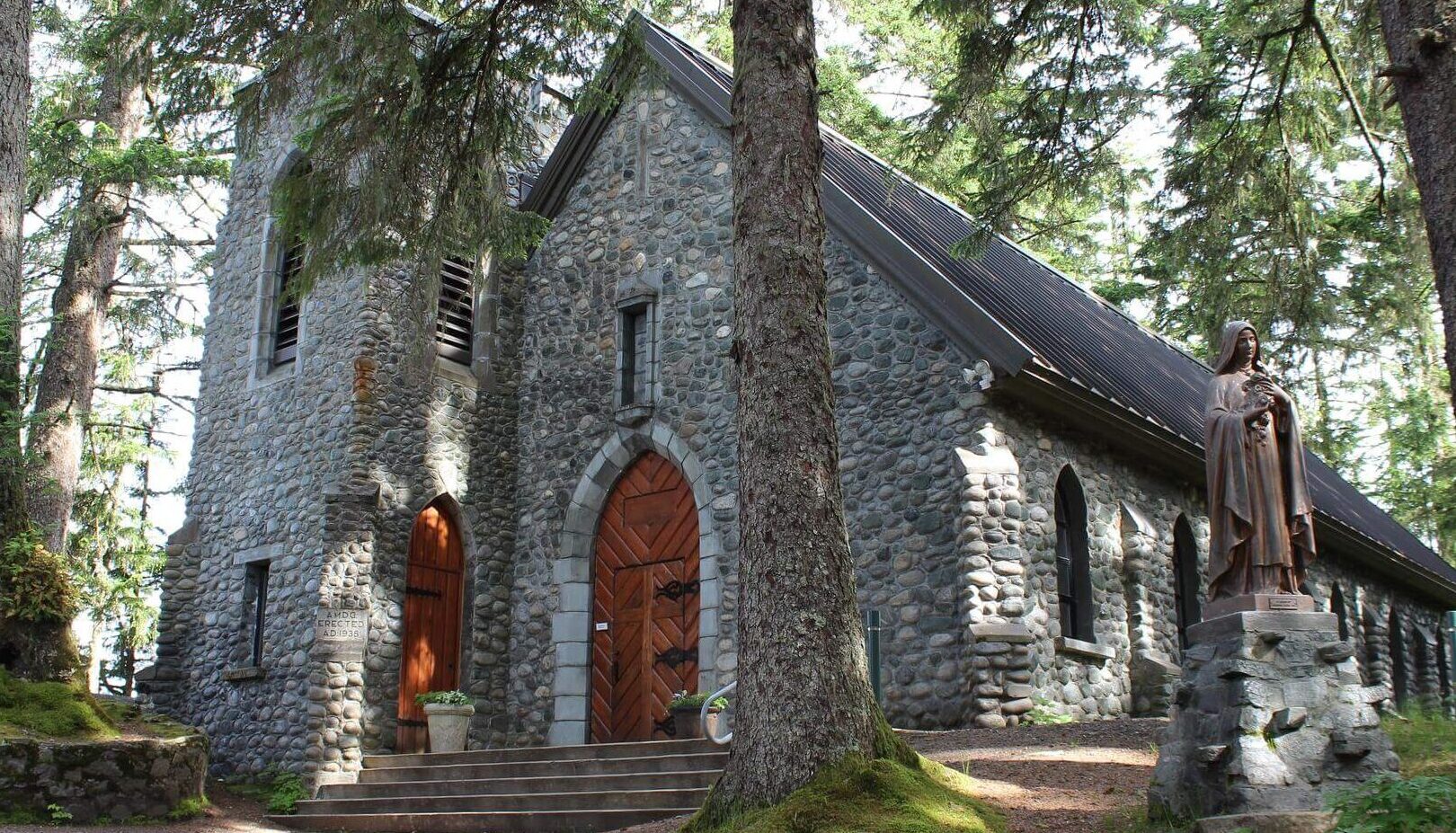
A Brief Timeline of the Shrine
Five acres of forest reserve land secured from the federal government
Lodge built to house the workers
Cornerstone of the Chapel laid on October 30 by Bishop Crimont
Stations of the Cross and Hermitage Cabin built
Columbarium and gardens built
Jubilee Cabin built
Little Flower Retreat Cabin and Merciful Love Labyrinth built
Post Office Cabin built
Shrine named a National Shrine by the United States Conference of Catholic Bishops
Shrine Support Facility built
Detailed History
1932 - Five acres of forest reserve land secured from the federal government
1933 - Lodge built to house the workers
1934 - Building of the causeway to Shrine Island begins
1935 - Additional five acres of land secured by Fr. LeVasseur
1937 - Work on the Chapel begins
1938 - Caretaker's Cabin built
1938 - The cornerstone of the Chapel was laid on October 30 by Bishop Crimont
1938-46 - U.S. Post Office at "St. Terese" in operation
1940s - Hermitage Cabin built
1941 - First Mass celebrated on October 28
1945 - Bishop Crimont died on May 20 and is buried in the Chapel Crypt
1945 - A particular act of U.S. Congress on September 24 (H.R. Bill 1992) secured the sale of the 46.61 acres from the government to the Catholic Bishop of Alaska
1946 - On July 16, Bishop Fitzgerald paid $116.25 to the District Land Office in Anchorage for the Shrine property
1953 - Bishop O'Flanagan initiated The League of the Little Flower to help make the Shrine more self-sufficient
1962 - Retreats stop being held at the Shrine, and the buildings deteriorate because the Diocese does not have the money to maintain the facility
1968-1969 - Major renovations take place under the leadership of Fr. James Manske, Director of the Shrine
Early 1970s - Central heating was added to buildings, which extended the use of the facilities into the winter.
1972-1973 - Shrine is staffed during the summers
1985 - Due to financial drain, the Shrine is forced to close in the Spring of 1985
1985 - On July 24, a small group of local people come together to save the Shrine.
1986 - The Shrine reopens in March
1989 - New engravings of the Stations of the Cross were installed in April
1998 - Columbarium and gardens built
2000 - Jubilee Cabin built
2001 - Little Flower Retreat Cabin built
2001 - Merciful Love Labyrinth built
2005 - The Shrine underwent extensive renovation work in the spring of 2005. Work included a new metal roof with added insulation, a new concrete slab with radiant floor heat added, insulation in all exterior walls, new steel windows with granite sills, an accessible altar area, new interior lighting, new landscape lighting and the exterior wall stones were cleaned and sealed. Great care was taken to maintain the essence of the original structure as well as maintaining the sanctity of the Shrine, which is the burial place of two beloved Bishops.
2013 - Major renovation of the Lodge began in May
2016 - Shrine was named a National Shrine by the United States Conference of Catholic Bishops.
2017 - Three Columbarium units Added
2018 - Shrine Chapel celebrates 80 years of service to the people of God
2019 - Summer Religious Presence Program started.
2019 - The Chapel Ceiling was Refinished, and a statue of the Blessed Mother was installed over the doorway.
2020 - Causeway to Shrine Island paved.
2022 - Shrine Support Facility - Shrine office, laundry, caretaker quarters, and Religious Apartment - completed and blessed by Archbishop Bellisario.
2023 - Celebration of Shrine Chapel's 85th year and the 150th year of the birth of St. Therese.
2023 - Priest and Religious Presence Program covers 2/3 of the summer season.
2024 - Three Columbarium units added
The Dream of the Shrine: A Story of Faith and Devotion
The dream of the Shrine of St. Thérèse is the story of people coming together to create something greater than themselves. It is a pioneer story typical of our country; it is also the Christian’s story of searching for God. In the Bible, there are many stories of special places being honored because the people had encountered God. These places are special not because of human effort, but because of the presence of the Divine. “The significant meaning of every shrine is to be a reminder in the faith of the salvific work of the Lord.” (The Shrine and the Pilgrim- age, p.4, USCCB)
The Shrine of St. Thérèse, with a retreat house and chapel, began as the dream of Father William G. LeVasseur, S.J. He envisioned a place that would call people to a greater devotion to God. He saw the need to provide a retreat house to help bring God’s people closer to the true source of all life. At this time, there were no other retreat houses in Alaska.
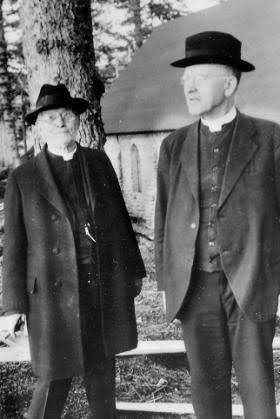
Bishop Crimont, S.J., D.D. and Father William G. LeVasseur, S.J. next to the Shrine Chapel
Bishop Crimont, S.J., D.D., the first bishop of Alaska, approved the process of securing five acres from the government in the forest reserve. Bishop Crimont was from St. Thérèse’s native France, and he knew members of her family. He also knew of her devotion to the missions while she was living, so he placed the entire Alaskan mission under her protection five years prior to her canonization. When St. Therese was canonized on May 17, 1925, Bishop Crimont was in Rome. At that time, she was declared Queen and Patroness of Alaska. Bishop Crimont’s devotion to St. Therese grew, and he did much to encourage others to develop the same devotion.
The Shrine was dedicated to this saint, known as “the Little Flower of Jesus,” who had died September 30, 1897, in the cloistered Carmelite convent at Lisieux. It truly is a wonder that we know anything about St. Thérèse. The Carmelite life is one of work and prayer in the convent, often referred to as the “hidden life.” Known for her “little way,” St. Thérèse wrote in her autobiography, The Story of a Soul, that what really matters in life is not our great deeds but our great love. She believed that God had a special love for “ordinary” persons and considered herself one of them. Thérèse believed that opportunities for loving occur most often in the ordinary events of one’s life and that by doing everything in life with great love, with God’s help, anyone can grow in holiness. Many favors and blessings, even miracles over the years, have been attributed to her intercession.
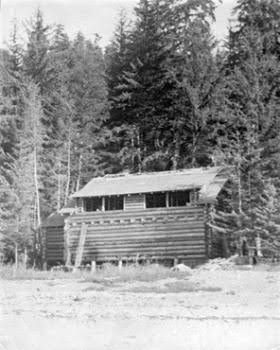
Partially completed Retreat House
The Shrine's Foundation: Retreat House and Chapel
The first part of the Shrine plan was to erect the retreat house, and in November 1933, it was partially completed. Henry Meyers, who lived at the Shrine for a while, was responsible for the log construction of the retreat house. Joe Smith, a local Juneauite, recalled that Meyers was a fascinating man from Germany who possessed five educational degrees. A Juneau firm provided 35,000 feet of lumber to construct several small cabins that could be used for private retreats and extra accommodations.
The plan’s second stage was to begin construction of the log church on Crow Island, the tiny island located about 400 feet from the mainland shore. Later, it was to be renamed Shrine Island.
The original cost estimate for the retreat house and chapel was $3,000, not including furnishings. Considering that these were the Great Depression years, fundraising was a monumental job. There was a persistent barrage of letters sent out, appealing for money. A.B. Cain of Juneau, editor of The Alaska Catholic, sent out as many as 500 letters each week. The parishioners of the Cathedral of the Nativity of the Blessed Virgin Mary parish in downtown Juneau did much of the envelope stuffing and appealing to their friends and relatives for donations. Money was donated in varying amounts – twenty-five cent and one-dollar donations were most common. Father LeVasseur wrote personal replies to each donor and remembered their intentions in his prayers.
Many of the mailings — asking for donations and help with the project — came from the post office established on the Shrine premises. This unique feature, in operation for only eight years, served a need for the area’s residents from July 1938 to July 1946. Many of the requests for financial help bore the cancellation stamp of St. Terese, Alaska. Much of the incoming mail with donations came through this little post office.
Support was also given to the project by Father B.H. Hubbard, who was known as the “Glacier Priest.” A Jesuit from Santa Clara University, Father Hubbard explored and photographed much of Alaska. In correspondence dated October 3, 1940, Father LeVasseur tells of how Father Hubbard visited for ten days and gave a lecture that raised $200 for the Shrine. The letter tells of Father Hubbard’s promise to help and refers to a generator he was sending.
Many specific dates and the actual schedule of completion have been lost. However, correspondence found in the Diocese of Juneau historical files can paint a picture of how the building progressed.
A fundraising notice stated: “The first logs for the retreat house, a necessary unit, were cut and towed to the site in 1932. The ground was broken that same year, and construction was started. Owing to the lack of skilled workmen and funds, the work on the Shrine itself, on Shrine Island, 400 feet from the mainland, was not fully underway until the summer of 1935. The causeway joining the island with the mainland had to be built first, and it proved to be quite an engineering feat owing to the high tides and severe storms.”
From correspondence of August 23, 1935, it was learned the retreat house was nearly completed. The dimensions and a description of the building were given. It was also in 1935 that Father LeVasseur applied for and obtained an additional five acres adjacent to the original tract.
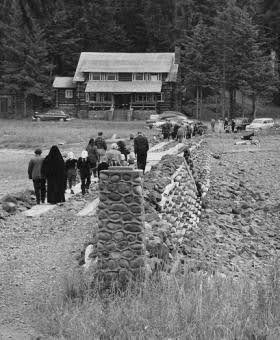
Walking across the causeway from the Chapel toward the lodge, 1940s
A report from Father LeVasseur as chancellor was sent to Bishop Crimont, who was at that time in Rome. The report, dated September 30, 1937, explains that “The causeway at the Shrine has proven to be a big work, but will be finished today. The two chimneys were completed and paid for last week. The work in the interior of the retreat house is progressing very satisfactorily. Harry (Ellingen) and his helper are working four days a week, while Mr. (Pete) Loftus looks after his work at the hospital. (St. Ann’s Hospital was run by the Sisters of St. Ann and was part of the Cathedral complex in downtown Juneau.) The grounds for the Shrine on the island have been cleared and the foundations dug.”
Also in 1937, in a fundraising notice sent out to the community, the Shrine was recognized as a permanent memorial to Bishop Crimont who had devoted so many years of his life to the Church and to the people of Alaska.
According to a letter sent to His Holiness, Pope Pius XII, in September of 1939, work on the chapel on the island was not started until the summer of 1937. The letter told of a volunteer from New York City, George Murphy, who cleared off all the trees and stumps, dug the foundation and helped pour the concrete in preparation for the stone structure which was to be built the following year. All this labor was done entirely free of charge — and without any previous experience in this line of work. Murphy returned in 1938 and assisted in building the chapel.
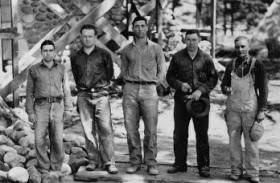
Burr Hagarty, Dick Kirschner, I.C. Clinkenbeard, Harvard Brown, D.P. (Doc) Holden (hat in hand)
D.P. (Doc) Holden was foreman of the chapel construction project. A skilled stonemason, he was also responsible for the fireplace in the lodge, and he supervised the enclosure of the ground space of the lodge so that the pilings were no longer visible. Most likely, Holden was instrumental in the change of plans that had the chapel built of stone rather than of logs. He and his wife lived in one of the cabins on the grounds while he supervised the stonework. The rock used for the chapel was taken from the beach near the shrine.
Doc is quoted as saying: “We had a hundred dollar truck, wheelbarrow, a mortar box, mortar hoe, rope and falls for hoisting stone, and a handmade skip. There were some bad times, but the work continued, and in time the chapel structure was completed.”
Juneauite Tony Thomas added some perspective to the events of the chapel construction on which he worked. He recalled the laying of the cornerstone on the Feast of Christ the King, October 30, 1938. The walls of the church were already up when the cornerstone was laid in the bell tower. Bishop Crimont blessed the stone which held a copper box containing time capsule items, information, and a film of the blessing ceremony. Fifty years later, on October 30, 1989, the time capsule was removed and the film was found. A video has been produced of the Shrine with some of the segments from the original film, along with other scenes that have been taken of the Shrine over the years. A new time capsule, blessed by then Bishop Michael Kenny and Archbishop Francis Hurley, along with the old one, was installed on May 29, 1989. It will be opened in the year 2038.
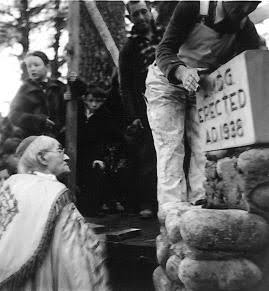
Bishop Crimont pictured as cornerstone is being put in place October 30, 1938
Regarding the ongoing work on the chapel, Tony Thomas said the roof was put on, and the workers began to form a crypt within the church. The chapel was built on rock, so the crypt had to be blasted out. The chief blaster from the A.J. Mine, Art Reindeau, did the work. Thomas said that Reindeau was so skilled in blasting there is perhaps only one chip on the trusses from a flying stray stone. The crypt holds six burial places; currently, Bishop Crimont and Bishop Kenny are the only ones buried there.
In a letter from Father LeVasseur to George Murphy dated September 14, 1939, he states that Mr. Holden returned that summer to finish the rock work on the Shrine. The crypt had been dug and cemented in, the roof had been placed, and the causeway had been raised to keep the water from washing over and destroying the driveway.
Another craftsman, Henry Ellingen, a carpenter by trade, made the doors and woodwork in the chapel and lodge. He laid out the chapel trusses in the gym of St. Ann’s School in Juneau to ensure accuracy. They were then dismantled and put on a flatbed truck to be transported to the Shrine. Ellingen is credited with making the Alaska yellow cedar pews in the chapel. Finished, the chapel measured 63×28 feet, with a 10×10-foot Notre Dame tower 28 feet high.
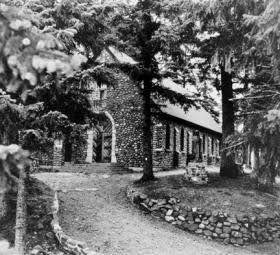
Shrine of St. Therese Chapel
In a letter from Father LeVasseur to George Murphy dated September 14, 1939, he states that Mr. Holden returned that summer to finish the rock work on the Shrine. The crypt had been dug and cemented in, the roof had been placed, and the causeway had been raised to keep the water from washing over and destroying the driveway.
The Alaska Daily Press of October 28, 1941 tells of the first Mass said in the Shrine chapel. Father LeVasseur said the Mass and Bishop Crimont blessed the bronze statue that was donated by the Nick Bez family in memory of their daughter.
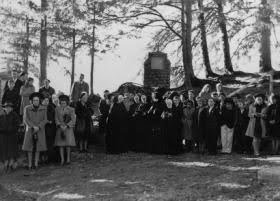
Group attending inaugural Mass and Blessing of Statue, October 28, 1941 on Shrine Island
Land Acquisition and Shrine's Self-Sufficiency Initiatives
Before the original project could be called finished, there remained one additional matter to ensure the perpetuity of the Shrine dream. The original land procurement was done with special use permits through the Department of Agriculture because the land was in the Tongass National Forest. The original permit was issued for the development of a residence, which came under the title of Special Use Permit. Because the development exceeded this, the purpose needed to be redesignated and the rental charge readjusted. The new permit was for an “organization site,” and the annual rent was $25. This action by Regional Forester B. Frank Heintzelman seemed to precipitate the process of acquiring the original tracts along with an additional acreage so that the total land available to the Shrine would be 46.41 acres. The difficulty was that the precedent 25 acres were permitted for an “industry.” A special act of Congress was required for the acquisition of the remainder of the desired property.
Support was generated with the endorsement of then Governor Gruening and the Alaska Territorial Legislature. Delegate E.L. “Bob” Bartlett introduced H.R. Bill 1992 in the U.S. Congress, which authorized the sale of certain public lands in Alaska to the Catholic Bishop of Alaska, in trust for the Roman Catholic Church. The bill was approved September 24, 1945, and it became a public law of the 79th Congress.
It was on July 16th of the following summer that the District Land Office of Anchorage received $116.25 from the Most Reverend Walter J. Fitzgerald, S.J., Bishop of Alaska. This was the full purchase price of the tract of land.
Bishop Crimont did not live to see the security of the Shrine vision reached. He died May 20, 1945, and was buried in the crypt of the Shrine chapel. Father LeVasseur was transferred to another diocese in August of that year. He left with the hope that the security and perpetuity of the Shrine was nearly complete.
An attempt to make the Shrine more self-sufficient was initiated by Bishop O’Flanagan. who founded “The League of the Little Flower” in 1953. His purpose was to “…seek the help of St. Thérèse, the Little Flower, patroness of the Diocese, in providing for the spiritual and temporal needs of the Diocese.” The League continued to be in existence until 1966. In 1987, Bishop Michael Kenny reinstituted the League under the patronage of St. Thérèse. The principal purpose in reinstituting the League was to provide spiritual support, especially for those making and giving retreats.
The Evolution of the Shrine's Stations of the Cross
Surrounding the chapel and built in the same style as the chapel walls — mortar and beach stone — are the fourteen Stations of the Cross. Each sheltered face is 24”x18” and the original scene placed in it was a picture protected by a glass covering.
The damp climate penetrated these, and the 1966 cast stone figures were set in place. It was at this time that a corpus was placed on the 16-foot cross that had been erected on the rise to the west of the chapel. Again, the salt water, air, and climate began to take its toll of the cast material. In 1986, a donation from two benefactors, Mary Toner and Vera Carrigan, enabled the Shrine governing committee to contract with a local artist to repair the existing stations.
R.D. Robinson declined to repair the stations, but did agree to create new sculptures for each of the fourteen stations and create a 15th station honoring the Resurrection of Christ. Cast of alabaster with a hint of onyx, the faces of the stations are done in what Robinson describes as a contemporary Renaissance style. Robinson’s work, including an additional fifteenth station, was dedicated on May 29, 1989.
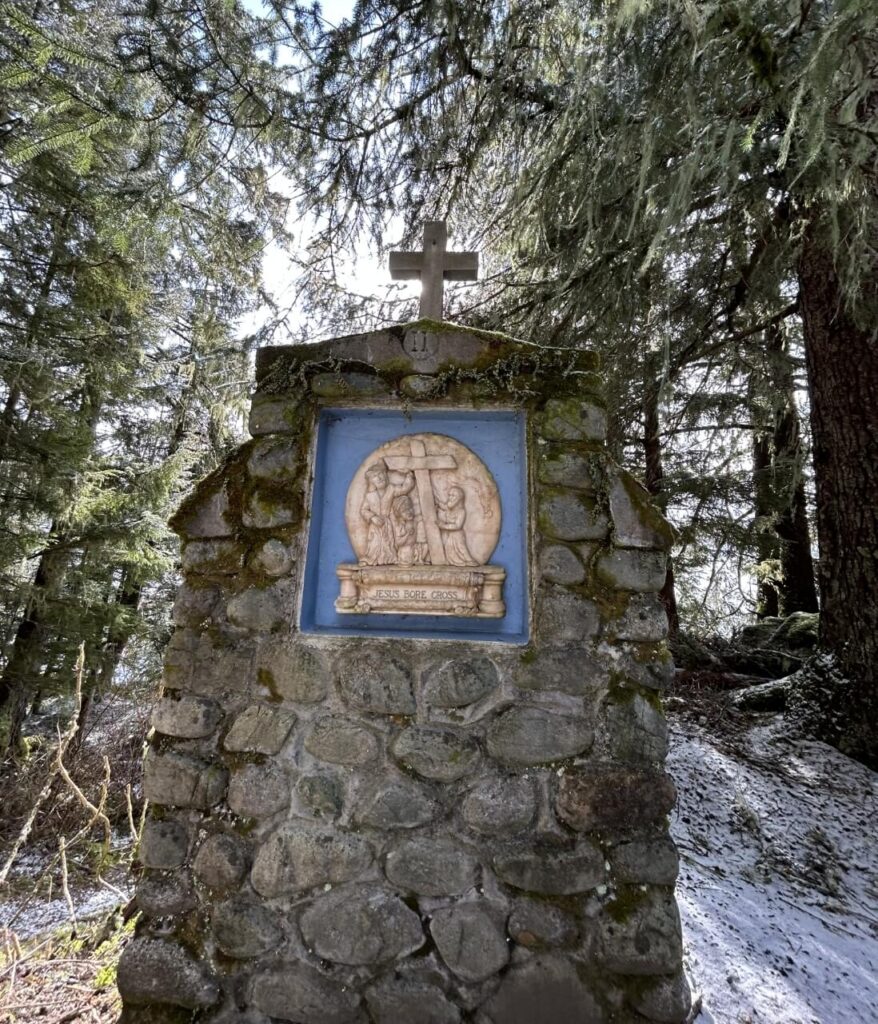
Stations of the Cross Sculpture
Rediscovering the Vision: The Restoration of the Shrine's Glory
Until 1958, the Shrine chapel and lodge were used for retreats, and the buildings continued to be in good condition. By 1962, the priests’ retreats were no longer held at the Shrine. The buildings deteriorated and the Diocese did not have the money to maintain the facility.
A major renovation took place in 1968 and 1969 under the leadership of Father James Manske, Director of the Shrine. As in the past, there was a great deal of volunteer help that made the facility ready for a priests’ retreat in May. The addition of central heating in the early 1970’s extended the use of the Shrine. During the summers of 1972 and 1973 the Shrine staffed and planned programs offered to the community. Once again, the financial drain of the Shrine maintenance forced its closure in the spring of 1985.
A small group of people, uneasy about abandoning the vision of the Shrine, would not let the dream die. They met July 24, 1985 with the goal of once again making the Shrine a viable retreat center. In March 1986, the Shrine of St. Therese was reopened. Thomas Fitterer took over as Shrine Director and was instrumental in bringing the Shrine back from the brink of abandonment. Under his direction, the Shrine saw the addition of several sites: the Columbarium (1998), the Rosary Walk (1999), the Jubilee Cabin (2000), the Little Flower Cabin (2001), and the Merciful Love Labyrinth (2001).
Columbarium
The Columbarium was constructed on Shrine property overlooking Pearl Harbor in 1998. A columbarium is essentially a graveyard for cremated remains. The structures are made out of black Zimbabwe granite columns divided into burial niches. This holy, blessed, and dedicated place for the interment of the cremated remains of loved ones is enhanced by the Biblical and Marian Gardens that flourish during the growing season each year. The plants found in these gardens are representative of similar or related plants mentioned throughout the Bible or found in Church tradition, particularly in relationship to the Blessed Virgin Mary. The initial research, development, and success of the gardens can be attributed to the ongoing efforts of Ed and Janis Burns-Buyarski.
Good Shepherd Rosary Trail
Located just across Shrine Creek is a recycled asphalt walking path called the Good Shepherd Rosary Trail. This path begins with a bronze plaque of the Good Shepherd, Jesus Christ, who reached out and cared especially for those who were less fortunate in the “eyes of the world.” The present form of the Rosary was established in the Middle Ages. The rosary is scripturally based, Christ centered, and a devotional prayer for many Catholics and non-Catholics alike. The trail consists of four areas for each set of the Mysteries of the Rosary: the Joyful Mysteries, the Sorrowful Mysteries, the Glorious Mysteries, and the Luminous Mysteries. The trail ends at the Grotto with a replica of Michelangelo’s Pieta.
Jubilee Cabin
The Jubilee Cabin, a log building located south of Shrine Creek on Jubilee Hill, was constructed in the Great Jubilee Year, 2000. A Jubilee Year calls one to come to know more deeply the great love that God has for each of his children. Found in Leviticus, Chapter 25, of the Old Testament, reference is made to celebrating the Jubilee Year with a call to forgive debts, free captives and prisoners, and restore justice. This cabin, constructed out of 13-inch diameter logs shipped in from Prince George, B.C., Canada, was the first new retreat building to be erected at the Shrine since the first building phase of the 1930’s. This modern and comfortable two-bathroom, four-bedroom facility is ADA-accessible on the first floor. It has a kitchen and a gathering/living room with a majestic view of the Inside Passage and Shrine Island. Being the second largest of the Shrine retreat facilities, it can accommodate 14 people comfortably.
The Little Flower Cabin
The Little Flower Retreat Cabin, found near the Shrine’s southern boundary, was built in 2001 and is nestled within the forest environment while facing the Inside Passage. Because this place is set apart from the rest of the Shrine facilities and sits seventy-feet above the water, it gives one a true sense of solitude and privacy. The structure itself was funded primarily from donations made by Vivian Kirkevold in memory of her late daughter, Heidi. Her intent was to provide funds to build a special place for people, particularly couples, to come for renewal. Being a modern facility, this cabin has a fine kitchen, dining room, gathering room, bathroom with shower and bathtub, and two bedrooms, each with a queen size bed. The panoramic view from the gathering room is breathtaking.
The Merciful Love Labyrinth
The Merciful Love prayer walk labyrinth was constructed in the spring of 2001. Just as they had done in the 1930’s to provide rocks for the Shrine Chapel, Stations of the Cross, and other building foundations as a labor of love, volunteers of all ages carried cobbles from the beach nearby for constructing the Merciful Love Labyrinth. Evidence of labyrinths have been found dating back four thousand years, but as of late there has been a re-awakening to the value of them. The Merciful Love labyrinth, laid out in patterns of concentric rings similar to the labyrinth found at Chartres, France, provides individuals of all faiths or no faith an opportunity to enter into a sacred spiritual experience. Some people equate the labyrinth with a maze, but they are really quite different. Labyrinths, symbols of the single path to the sacred center, have no confusing dead-ends or false pathways; mazes, on the other hand, have many paths, purposely designed to confuse and dupe the person navigating them. As Janis Burns Buyarski shares, “Labyrinths are part of the mystical tradition which looks for a direct connection to the Divine. It is a part of the “kinetic knowing,” of praying through moving the body… In a time when many people are seeking ways to integrate psychology with spirituality, the labyrinth creates a safe, open space where the inner and outer meet and become one…Labyrinths are symbols of the path to the sacred center, and a metaphor for the human journey of life.” St. Thérèse of Lisieux, our Shrine patron saint, came to know the truth of the “merciful love” that God has for his creation. She knew that this merciful love from God was an invitation to allow the love of God to flow through her into the lives of others.
The Post Office Cabin
In 2010, after over 70 years of use and exposure to the elements, the Post Office Cabin was demolished and rebuilt. With a bed in the loft and two singles on the main floor, the cabin welcomes small groups to its location overlooking the labyrinth. The new sign on the Post Office Cabin still has the original, incorrect spelling of St. Terese that can be found on canceled stamps from the days when the Post Office really was a post office.
The Lodge
The next major project was the Lodge. After 80 years, the Lodge had seen better days, and there was significant concern about its structural integrity. The Board had voted to demolish the Lodge and focus on building a new retreat center. John Gitkov, marine salvager and neighbor of the Shrine, didn’t want to see the Lodge go. He created a plan to save the Lodge and after approval from engineers, John led a group of paid and volunteer workers in the restoration. On September 1, 2013, Bishop Edward Burns and the Shrine Board hosted a barbecue to thank all the workers who gave so much time and effort to the project.
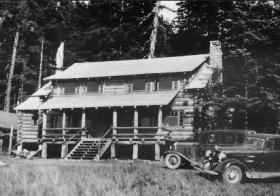
The Shrine Lodge
Milestones and Blessings
October 1, 2016, Bishop Edward J. Burns announced that the United States Conference of Catholic Bishops (USCCB) and its Committee on Divine Worship had designated the Shrine of Saint Thérèse of Lisieux, Juneau, Alaska, a National Shrine.
Three units were added to the Columbarium in 2017, bringing the total number of installed units to nine. The original 50 year columbarium plan provides for 18 columbarium units.
Shrine Chapel celebrated the 80th year of the laying of the cornerstone in 2018. Bishop Andrew Bellisario, CM, was the main celebrant. Mr. Albert Shaw was among the faithful gathered for the Anniversary Mass. Albert served at the first Mass celebrated in Shrine Chapel in 1941.
In January and February of 2019, Shrine Board member Dennis Brooks refinished the ceiling of Shrine Chapel. The beautiful post and beam construction was in dire need of cleaning and resealing. The project took six weeks, and in the seventh week, Dennis painted the interior walls.
2019 also saw the installation of the statue of The Blessed Mother above the entryway door to Shrine Chapel. The granite statue was tucked neatly into a niche that had been empty above the door for 80+ years. Shrine volunteers Tim Dimond and Sam Bertoni managed the project. Fr. John Carvelle, visiting priest from the Diocese of Baton Rouge, blessed the beautiful statue.
Mr. Jim Wilcox sponsored the paving of the Causeway in 2020. The new asphalt was a Godsend to Shrine pilgrims with mobility issues.
On the Feast of St. Therese in 2022, Archbishop Andrew Bellisario, CM, blessed the new Shrine Support Facility. The Shrine office took up residence in the new facility on November 1. The facility replaces the old caretaker cabin with a new caretaker apartment, laundry, office and visiting priest apartment.
The Summer Priest Program, which provides daily Mass and Confession for pilgrims, was staffed for more than two-thirds of the summer season. Archbishop Andrew celebrated the annual St. Therese Feastday Mass marking the 85th anniversary of the laying of Shrine Chapel’s cornerstone, the 90th anniversary of Shrine Lodge and the 150th anniversary of the birth of St. Therese.
By God’s grace, the National Shrine of St. Therese will continue to serve the needs of pilgrims journeying to Southeast Alaska for many years to come.
Volunteers, the Backbone of the Shrine!
From the beach stones gathered that make up the walls of the Shrine Chapel to the plants that grace the Marian and Biblical Gardens, all are the work of volunteers giving their time for the greater glory of God. Are you being called to this work?